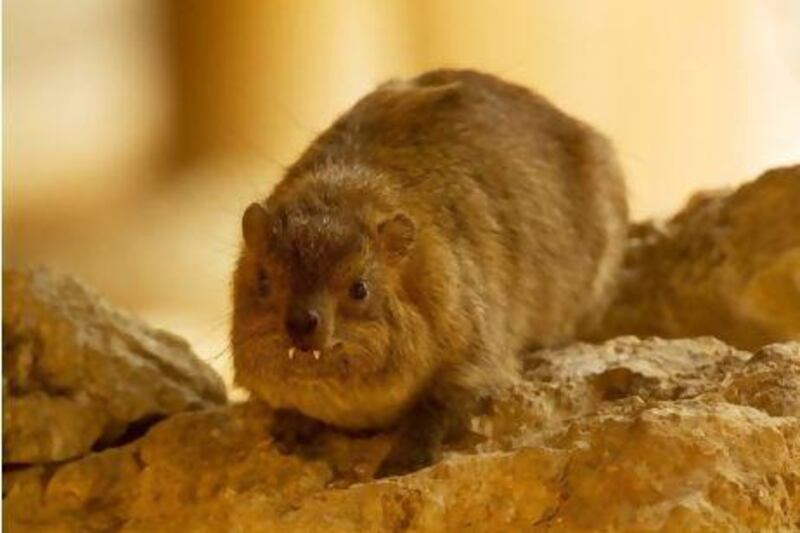I'm new in town, I'm ready to mate, and this is exactly how hot I am.
It's a bold, honest message - and the first thing a male rock hyrax broadcasts when he arrives in a new area. The mammal - a furry, marmot-like creature found on Jebel Hafeet - usually communicates in quiet noises or loud, repetitive warning trills.
But one in three adult males sings a very different tune - a rich, highly structured song that advertises its vital statistics: body weight, size, condition, social status and hormone levels.
The hyrax is a strange beast indeed. It has toes like an elephant, it heats itself like a lizard, and digests food like a horse.
"It still blows my mind," says Dr Majid Al Qassimi, the hyrax caretaker at Al Ain Zoo. "You look at them and you're like, 'no way'."
It is the sole survivor of a group of herbivores that in its prime, more than 34 million years ago, included species as small as mice and as big as horses.
Today, only three members of the group remain: the hyrax, the elephant, and sea cows.
The hyrax, Procavia capensis, is common today across Africa, the Middle East and the Arabian Peninsula and is well-adapted to arid climates.
Like its more lumbering relatives, it has four functional toes and sensitive padded feet. Also like elephants, it has tusk-like front teeth, a high brain function and a good memory.
Its long nasal passage, another shared trait, helps with heat exchange that allows it to survive the hot climes of the UAE.
Many of the UAE's hyraxes descend from the collection of a careless Saudi pet owner whose 20 hyraxes escaped about 13 years ago.
The ecologist, Peter Cunningham, believes he spotted the escapees in 1999. The six hyraxes he saw looked like the subspecies Syriaca, which is native to Saudi Arabia and the Levant. Their descendants now dwell on and around Jebel Hafeet.
There, they live in mixed-sexed groups. The females rule the roost, having the highest social ranks and staying in the same group for life - and, uniquely, having as much or more testosterone than the males.
The males, meanwhile, are relative itinerants, staying in a group for no longer than three years before moving on or becoming relegated to the periphery.
During the short mating season, the males have to compete for the females' attention, not only with the other males in the group, but with those hanging around the periphery. And they do so with song.
The songs, which last a few minutes and can be heard by humans up to 500 metres away, instantly showcase their wares in a series of wails, chucks and snorts, giving potential mates instant and honest information.
It's not a deliberate transfer of information, as such; rather, the timbre and complexity relay candid vital statistics, similar to the way the human voice gives clues about health and virility (think how easily you can tell the voice of a young man from an elderly grandfather).
Heavier males make louder sounds, and more "chucking" noises in addition to wails and snorts, perhaps because of their larger lungs. Singers with fuller fur coverage make a richer sound.
The males who sing are usually older, more dominant, have higher stress hormone (cortisol) levels and mate more often.
The songs are as complex as birdsong, but not complex enough to be considered a language, and no two songs are alike.
And they sing with a regional dialect, embellishing their own repertoire with influences from neighbours. "Birds are known for complex songs but even in birds it's not very common to see the kind of variation we see in hyrax," says Arik Kershenbaum, the lead author of a recent study published in leading biology journal Proceedings of the Royal Society B.
"If you combine them into long strings of notes its the order of those sounds which we found was significant."
With algorithms developed for analysing genetic sequences, the researchers from the University of Haifa looked at the syllable order - and therefore the complexity - in a large number of hyrax songs.
And they found that just as a man might woo a lady by strumming the guitar, the complexity of a hyrax's song can capture the heart (or hormones) of his mate.
The complexity of the song indicates the male's overall fitness. And the more complex the song, the more successful he was likely to be in breeding.
"It demonstrates how evolutionary language abilities, language and syntax, how they might have arisen unrelated to fitness benefits, in this case [for] advertising complexity," said Mr Kershenbaum.
But singing is not without cost. It takes time and energy, and as well as alerting females, it tips off potential predators.
So the hyrax tend to sing from lookout points, such as boulder tops, to give themselves a chance to see approaching predators. In any case, most of the singers are too big to be victims of birds of prey.
When it's over, it's over. Resident males that stop singing disappear from the group soon after. In all probability they move to another group, or hang around on the periphery in the hope of getting lucky. And, perhaps, ruing the fact that they couldn't sing a better song.






